GEOLES – Ještěrka obecná
Naším posledním obyvatelem geolesa je ještěrka obecná, jejíž souřadnice snadno vypočítáte, pokud jste si poznamenali čísla pro tuhle bonus kešku u předchozích zvířátek. Na úvodních souřadnicích ještěrku nehledejte, ale to znáte.:-) A jdeme na to:
Medvěd hnědý /GC4Y661/ = A
Liška obecná /GC4YPTG/ = B
Ruská modrá kočka /GC4ZB4J/ = C
Jelen lesní /GC4ZPB4/ = D
Panda velká /GC50HRY/ = E
Netopýr velký /GC51HWA/ = F
Sova pálená /GC52GWC/ = G
N 50° 21.A + B + C + D + 651
E 014° 32.E + F + G - 52
Teď už nic nebrání odlovu ještěrky (pokud budete v geolese poprvé a budete si chtít odlovit tuto bonus kešku, tak si pandu nebo sovu odlovte mezi posledními).:-)
Ještěrka obecná (Lacerta agilis) je jeden z nejrozšířenějších druhů ještěrky v České republice. Žije pod kameny nebo ve skulinách.
Celková délka ještěrky obecné činí kolem 20-25 cm. Tělo měří až 9 cm a ocas je jedenapůlkrát delší než tělo. Hlava je širší s krátkým čumákem. Na krátkých končetinách je 5 prstů, jež jsou zakončeny drápky, které umožňují dobrý pohyb po kamenech a různorodých materiálech. Ocas umožňuje lepší dynamiku pohybu a slouží také při útěku před nepřáteli, často se od těla při napadení odděluje, ale znovu se regeneruje a dorůstá.
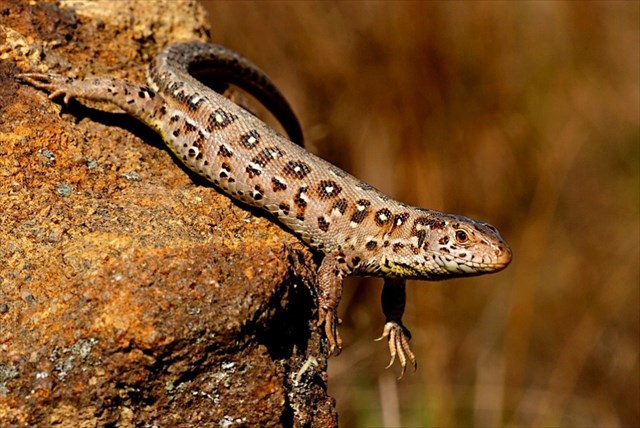
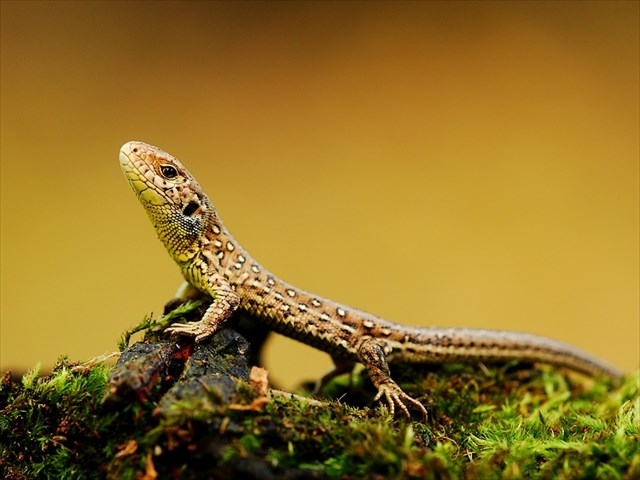
Přesto, že je u nás druhem chráněným, patří do druhů ještěrek u nás nejrozšířenějších. Je rozšířená na většině území střední a východní Evropy, v Asii až po západ Číny, ale její početnost silně poklesla, díky ztrátě stanovišť. Obývá především suchá a slunná místa a to stráně, i okraje lesů. Většinou pobývá do výšky 2500 m n. m. Při větších výkyvech teplot raději zalézá do úkrytů. Každý jedinec má svoje území, kde loví, klade vejce.

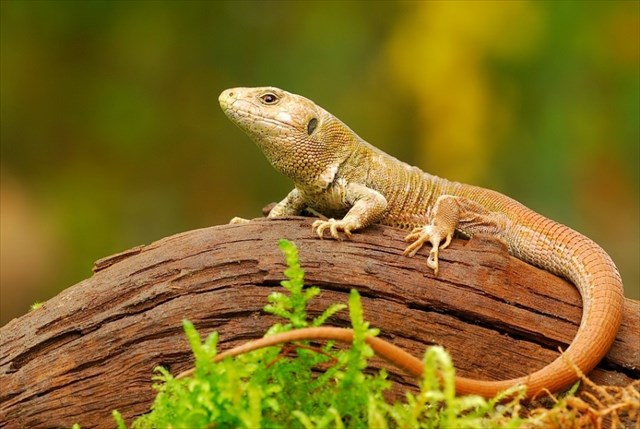
V jídelníčku ještěrky obecné můžeme najít menší hmyz (mouchy, brouky), také pavouky, červy, plže a pozemní korýše (svinky). Menší kořist rovnou polyká. Ještěrka loví především ve slunných dnech a kořist dokáže ulovit i za letu.
Ještěrky se rozmnožují květnu a červnu. Samice naklade do vyhloubené jamky v písku, mechu, hlíně či suché trávě 3-15 kožovitých měkkých vajíček o velikosti cca 15x8 mm. Kolem půlky měsíce července (většinou po 56 dnech) se vylíhnou mláďata, jež dosahují délky kolem 5-6 cm. Již od vylíhnutí jsou odkázána pouze na sebe a potravu si musí shánět sama. Dospělosti dosahují v 1,5-2 letech.
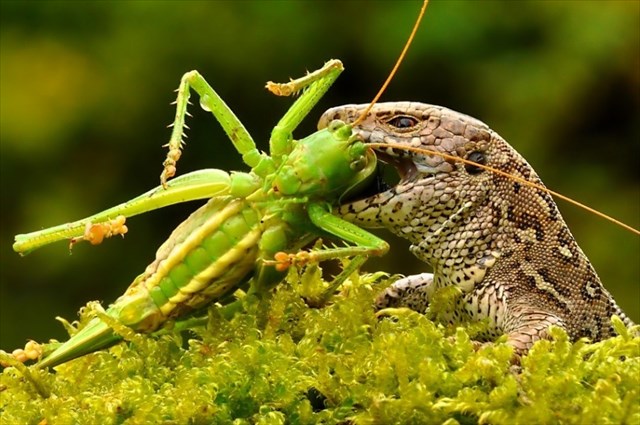
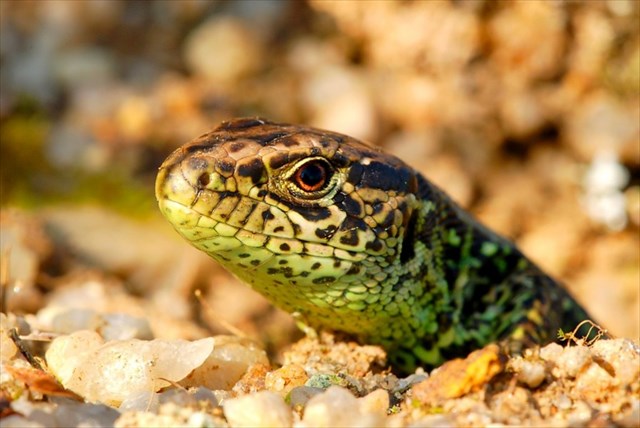
Ještěrka je nejaktivnější v ranních a podvečerních hodinách. V zimním období upadá do zimního spánku. Většinou zalézá do opuštěných nor savců (např. hraboši), pod kořeny stromů, různých skulinek. V dubnu se probouzí ze zimního spánku.
Má ve svém okolí mnoho nepřátel, mezi ně patří například lišky, volavky, čápi a další predátoři. Při poškození ocasu se v části, kde má svaly nejtenčí, poruší a ocas se oddělí.
V České republice je zvláště chráněna jako silně ohrožený druh, je tedy mimo jiné zakázán i její odchyt, chov v zajetí a prodej. Chráněna jsou i její vývojová stádia a sídla.
zdroj: wikipedia
GEOFOREST – Sand lizard
The sand lizard is our last resident of geoforest. You will calculate its coordinates easily if you noted the numbers for this bonus cache at previous animals. Don´t look for lizard at the initial coordinates, but you know.:-) Here we go:
Brown bear /GC4Y661/ = A
Red Fox /GC4YPTG/ = B
Russian Blue /GC4ZB4J/ = C
Red deer /GC4ZPB4/ = D
Giant Panda /GC50HRY/ = E
Greater mouse-eared bat /GC51HWA/ = F
Barn owl /GC52GWC/ = G
N 50° 21.A + B + C + D + 651
E 014° 32.E + F + G - 52
Sand lizard, Lacerta agilis
History and origin
The Sand lizard was first described by Linnaeus in 1758, the scientific name of this species is Lacerta agilis. Lacerta from latin meaning lizard. Agilis comes from latin and means 'agile' which is not the case for this lizard unlike other Lacerta sp.
Characteristics
They are characterised by their bulky bodies and their usual darker top of back.
Description
=Size=
They hatch at around 2 to 3 cm long, averaging about 8 cm long growing up to sometimes 10 cm long (measures not including tail, max. adult size tail included is up to 22 cm long).
Geographical range
Found throughout central and eastern Europe, found in the Balkans except for most of Greece, the whole of Eastern Europe, Austria, most of Switzerland, all of Germany, Denmark, southern Sweden, in France they are found in the French alps, Jura and Massif central mountains as well as a small area in the eastern Pyrenees where it is also found in Spain. It was introduced into multiple areas in the UK and is found in 3 main populations in southern England and north west England (although native to the Merseyside area).
Sexual differences
Visible differences are in the patterns, males usually have green flanks where as females are usually brown, for more information please read patterns & colours above.
Seasonal variations
Females are larger in spring due to their eggs.
Diet
They feed mainly on large insects.
Defensive habits
They usually flee at first chance, if caught they don't bite.
Reproduction
Breeding occurs when they wake up from hibernation in spring, a week after, they are all looking for each other and mating begins. After only a few weeks about 10 eggs are laid (extremes are from 4 to 14 eggs) in a moist, warm spot, usually under hey piles, in rotting wood piles and other places of this kind. The eggs incubate for around 10 weeks before hatching.
Sexual maturity, life span
The average life span for Lacerta agilis is about 12 years, they reach their sexual maturity when they are two years old for males and three years for females.
Habits
They are active by day. They can be found in densities of 30 to 100 per hectare in suitable habitat. They are more intelligent then other green lizards as they seem to be able to sense changes around then and adapt according to different situations such as a threat, rain, sound/vibration.
Habitat
Their typical habitat consists of typical Mediterranean scrub land, dry often densely vegetated with small open areas scattered in places. they are found up to 1000 m in altitude except for southern Spain where they live up to 2100 m in altitude, although they are less common here.
Predators
This species is hunted by birds of prey, snakes (Malpolon most common and only for fully grown specimens). One of the most damaging factors to their populations is cars and humans as we are responsible for the destruction of their fragile habitat. They only real natural predator for a fully grown specimen is a fully grown Montpellier snake, who are the only animal who is capable of immobilising an animal of this size.
source: herpfrance.com/reptile/sand_lizard_lacerta_agilis.php